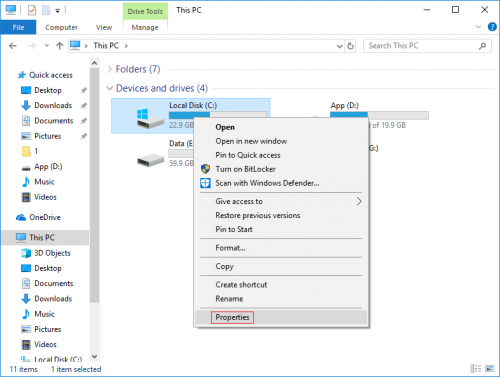Many people encountered low disk space issue in Windows 10 computer. Windows Updates, system log, temp, programs and many other types of files are writing to C drive continuously, so C drive is full sooner or later. If you replace disk with a new one, hard disk manufacturers will be very glad. In this article, I'll introduce how to clean up C: drive in Windows 10 to reclaim disk space. You may run Disk Cleanup in Windows 10 via command or GUI wizard. If you cannot get enough free space, try additional effective methods.

About Windows 10 Disk Cleanup utility
"Disk Cleanup" is a Microsoft Windows computer native included maintenance utility that is used to free up disk space on hard disk drives. This utility is easy to use and runs fast. It analyzes the hard drive and searches for files that are no longer of any use, and then removes the unnecessary files safely. These unnecessary and junk files include Windows Updates, Temporary files, Logs, Cache, files in Recycle Bin, etc.
You can run Disk Cleanup in all Windows versions from XP, however, in some Windows version such as Server 2008 and 2012, Disk Cleanup is not enabled by default, so you need to manually install this component. Starting with Windows 10 version 1803, Disk Cleanup are incorporated into Windows 10's Settings app, however, the standalone Disk Cleanup utility is still available.
How to open Disk Cleanup in Windows 10
There are 3 common ways to open Disk Cleanup in Windows 10 laptop/desktop/tablet computer:
① Press Windows + R key on keyboard, type cleanmgr, and then click OK.

Select C: drive or other one that you want to clean up.

Click Disk Cleanup in the pop-up window.
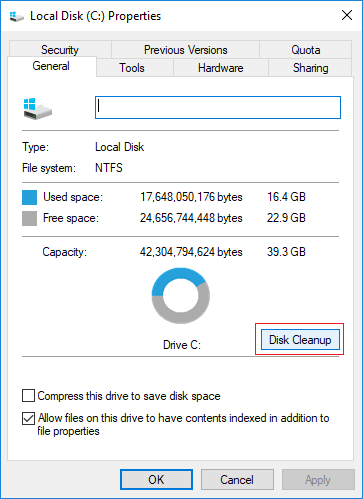
③ Search from task bar at bottom left. Type clean then Disk Cleanup is shown on the top.
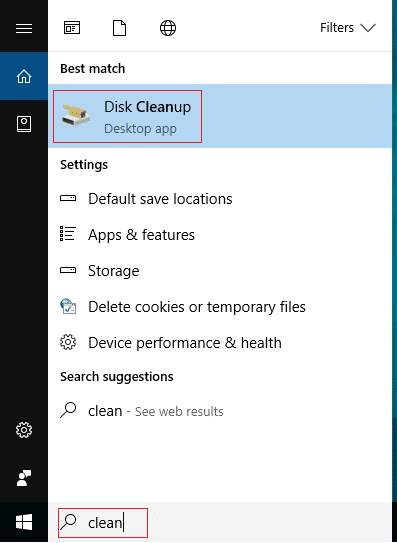
How to clean up C drive in Windows 10 with wizard
When the Disk Cleanup window is opened, it is very easy to complete the next steps, only several clicks are needed.
Steps to run Disk Cleanup in Windows 10 to clean up C drive:
1. Click the check-boxes to select the files that you want to remove and click OK to begin. If you are not sure about the meaning of these files, click it and you'll see corresponding description on the bottom.

2. Confirm this operation by clicking Delete Files.
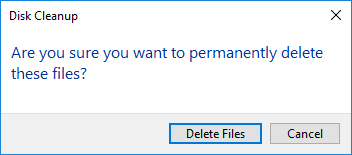
After that, Disk Cleanup will begin deleting the unnecessary and junk files.

3. Repeat to Clean up system files.
How to clean up disk in Windows 10 with command
There are 3 ways to run disk cleanup in Windows 10 via command line, select the one that fit for your needs.
① Command with all files selected
- Press Windows and R together on the keyboard.
- Input cleanmgr /LOWDISK and press Enter.
- Disk Cleanup dialog box will pop up with all types of files selected by default, so you just need to click OK to confirm.
② Clean up all junk files automatically
- Press Windows and R together on the keyboard.
- Input cleanmgr /VERYLOWDISK and press Enter.
Then Disk Cleanup will delete all junk files automatically and then show you a dialog box with result.
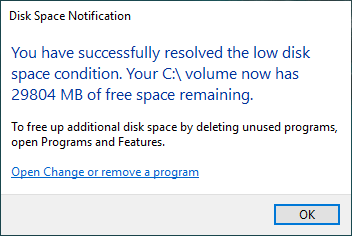
③ Clean up specified junk files automatically
- Press Windows and R together on the keyboard to open Run.
- Input cleanmgr /sageset:1 and press Enter. (You can specify the value from 0 to 65535).
- Disk Cleanup dialog box will pop up, select the files to delete and click OK.
- In the future, you just need to run cleanmgr /sageset:1 and press Enter, the preselected junk files will be deleted automatically. If you want to delete different types of files, input cleanmgr /sageset:2 in step 2 and run cleanmgr /sageset:2 in step 4.
5. Additional options after cleaning up disk
If you did not get plenty of free space after running Disk Cleanup in Windows 10, the 3 methods below are very useful.
① Move installed apps and games
When installing programs, many people use default settings to C: drive. The more you installed, the less space left. It's better to install programs to separated partition. Better than previous versions, Windows 10 can move applications installed from Windows Store to other partition without reinstalling.
How to clean C drive in Windows 10 by moving applications:
- Press Windows and X on keyboard, then click Settings > Apps > Apps & features
- Click an app or game.
- Click the Move bottom.
- Select the new location from the drop-down list.
- Click the Move button.
- Repeat the steps to move more items.

② Save files to new location
Windows 10 has another new option to save new files of apps, documents, music, pictures, and videos to other place, steps:
- Press Windows and X on keyboard, then click Settings
- Click System> Storage.
- Click Change where new content is saved under More storage settings.
- Click the drop-down list to select new location and click Apply.

③ Move more free space to C: drive
If you cannot reclaim large amount of disk space (at least 20GB), C drive will be full again in the near future, so you'd better allocate more space to C drive. In most of computers, there is free space in other partition on the same disk, NIUBI Partition Editor can move these free space to C drive without losing data. Operating System, programs and associated setting keep the same with before. It has free edition for Windows 11/10/8/7/Vista/XP home computer users.
Download this tool and follow the steps in the video to increase C drive space:
Besides shrinking, moving and extending partition, this free tool help you copy, convert, defrag, hide, wipe partition, scan bad sectors, optimize file system and much more.

